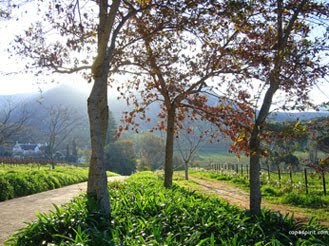In Sense and Sensibility, Mrs. Jennings, like every good soul, believes that is possible to cure all illness with a drop of any beverage - from water with sugar to wine. After Marianne's unfortunate encounter with Willoughby in London, she has a conversation with Elinor:
.JPG)
“My dear,” said she, entering, “I have just recollected that I have some of the finest old Constantia wine in the house that ever was tasted, so I have brought a glass of it for your sister. My poor husband! how fond he was of it! Whenever he had a touch of his old colicky gout, he said it did him more good than any thing else in the world. Do take it to your sister.”
As Marianne was already asleep, Elinor, even amused at the vaunted efficiency of that wine for so many problems, decided to drink herself the wine, since she's also had her heart broken too!
The label states 1883 and 1821.
Short history of Constantia Wine
In 1659, two Dutchmen named Jan van Riebeeck and Hendrik Boom planted the first grapes in the Cape, South Africa. These vineyards were later acquired by Governor Simon van der Stel, who gave that name to the wine, probably in honor of the officer's granddaughter Company Dutch West Indies, Constantia van Goans, who granted him the farm - which is to say, almost the entire valley. When he died in 1712 the heirs divided the farm into lots to be sold.

Image from Cape Spirit
In 1778, Hendrik Cloete, the new owner began its effort to revive the plantations that were much neglected. The years 1800 to 1818 were the pinnacle of fame of the wine of Constantia. His sons inherited the property: Jacob Pieter got the party appointed Groot Constantia and Johan Gerhard Cloete got Klein Constantia, where he built the manor of the same name. Johan produced the wine until 1840 when he sold the property.
After this division, which remains to this day the estates were sold to various owners. The Groot Constantia has several wines using the words "Constantia" and "Constance" and Klein Constantia has a wine called "Vin de Constance," sweet wine that is a re-creation of old Constantia. These wines are now a days knowed as "cult wines".
During this period, the late 18th and early 19th, therefore the Jane Asuten Era, the vineyards and particularly the Old Constantia, or Vin de Constance was at the height of its fame. Here we can see that the Austen used to consume that finest wine.

- Site Groot Constantia
- Site of Klein Constantia
- Bibliography: The Story of Wine, Hugh Johnson (in portuguese)
Published as "O bom e velho Constância" at Lendo Jane Austen
More on the topic:





